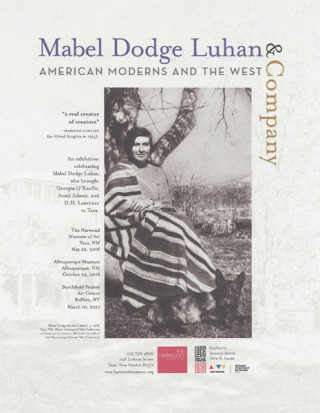by Elizabeth Cunningham
“Major Mabel Dodge Luhan exhibit slated for 2016.” So read the first press release announcing the Mabel Dodge Luhan and Company: American Modernism in the West exhibition. It didn’t make print in The Taos News, but was featured in the newspaper’s on-line edition. The release gave a synopsis:
The exhibition will be the first to showcase the impact of Mabel Dodge Luhan (1879-1962), and her circle of artist, writer, and activist friends, on shaping American Modernism. The exhibition is an exploration Mabel Dodge Luhan’s life and influence, within the context of early 20th century American history and the Southwest, and an exploration of how the tiny multicultural community of Taos became an important center of the modernist art movement.
On May 22, 2016, this landmark traveling exhibition opens at the Harwood Museum of Art in Taos. The executive summary states the show’s main purpose: to heighten audiences’ “understanding of modern American art and culture by examining Mabel within the broad circle of her ‘company’ and their regional, national, and transnational interactions.”
Set up to follow Mabel’s life chronologically, the exhibition is divided into eight sections. Each segment tells a story emblematic of the era. As her story unfolds, it follows Mabel’s shift from 19th -century Victoriana to American modernity and the Southwest. Sections I-III provide the back story, evoking Mabel’s Buffalo childhood; her expatriate years in Florence, Italy; and her role as a New York salon hostess. The Taos sections (IV to VIII) present the works of the modernists Mabel attracted to Taos.
Encompassing 133 works of art, Mabel and Company includes 45 paintings, 36 photographs, 39 works on paper, and 13 sculptures by such luminaries as Marsden Hartley, Georgia O’Keeffe, and Paul Strand of the Stieglitz Circle. Numbering among the Taos artists are Andrew Dasburg, Ernest Blumenschein, and Dorothy Brett. Supplementing the art works are publications produced over a 40-year time span. These will be augmented by music, audio, and video installations of pieces by Willa Cather, D. H. Lawrence, Martha Graham, Robert Edmond Jones, and other creatives. The work of these artists will be presented in relation to Pueblo artists, like Awa Tsireh and Pop Chalee, and Hispano artists, including santeros José Rafael Aragon and Antonio Molleno, in order to examine the cultural exchange that formed a unique “Southwest Modernism”.
After delving into the exhibition set up, it occurred to me that its breakdown provides a perfect forum for discussing the diverse aspects of Mabel’s life and times. So many themes, so little time. Stay tuned.
